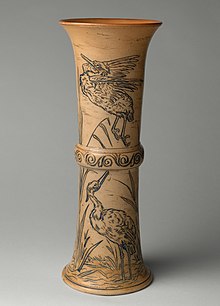
Art pottery is a term for pottery with artistic aspirations, made in relatively small quantities, mostly between about 1870 and 1930.[1] Typically, sets of the usual tableware items are excluded from the term; instead the objects produced are mostly decorative vessels such as vases, jugs, bowls and the like which are sold singly. The term originated in the later 19th century, and is usually used only for pottery produced from that period onwards. It tends to be used for ceramics produced in factory conditions, but in relatively small quantities, using skilled workers, with at the least close supervision by a designer or some sort of artistic director. Studio pottery is a step up, supposed to be produced in even smaller quantities, with the hands-on participation of an artist-potter, who often performs all or most of the production stages.[2] But the use of both terms can be elastic. Ceramic art is often a much wider term, covering all pottery that comes within the scope of art history, but "ceramic artist" is often used for hands-on artist potters in studio pottery.

The term implied both a progressive design style and also a closer relationship between the design of a piece and its production process. Art pottery was part of the Arts and Crafts movement, and a reaction to the technically superb but over-ornamented wares made by the large European factories, especially in porcelain.[3] Later art pottery represented the ceramic arm of the Aesthetic Movement and Art Nouveau.[4] Many of the wares are earthenware or stoneware, and there is often an interest in East Asian ceramics, especially historical periods when the individual craftsmen had been allowed a large role in the design and decoration. There is often great interest in ceramic glaze effects, including lustreware, and relatively less in painted decoration (still less in transfer printing).[5]

Throwing pieces on the potter's wheel, which hardly played any part in the large factories of the day, was often used, and many pieces were effectively unique, especially in their glazes, applied in ways that encouraged random effects. Compared to the production processes in larger factories, where each stage usually involved different workers, the same worker often took a piece through several stages of production, though studio pottery typically took this even further, and several makers of art pottery, if they became successful, drifted back towards conventional factory methods, as cheaper and allowing larger quantities to be made.[6]
The most significant countries producing art pottery were Britain and France, soon followed by the United States. American art pottery has many similarities, but some differences,[7] with its European equivalents. The term is not often used outside the Western world, except in "folk art pottery", often used for some village-based mingei traditions in Japanese pottery.[8]
- ^ Bergesen, 213; Muller, 60; see also the ranges in the titles of the books in further reading. The term has had a rather longer life in America.
- ^ Cooper, 206; Jacobs, 19; Osborne, 132; this is famously and most emphatically stated by Bernard Leach on the first page of his A Potter's Book (Faber, 1940)
- ^ Savage, 24–25
- ^ Sullivan; Bergesen, 213
- ^ Bergesen, 246; Sullivan
- ^ Jacobs, 17–21; Ellison, 261–262; Osborne, 132
- ^ Jacobs, 17–18
- ^ Wendy Jones Nakanishi, "The Anxiety of Influence: Ambivalent Relations Between Japan's 'Mingei' and Britain's 'Arts and Crafts' Movements", Electronic Journal of Japanese Studies, 28 October 2008; Moeran, Brian, Folk Art Potters of Japan: Beyond an Anthropology of Aesthetics, 2013, Routledge, ISBN 1136796738, 9781136796739